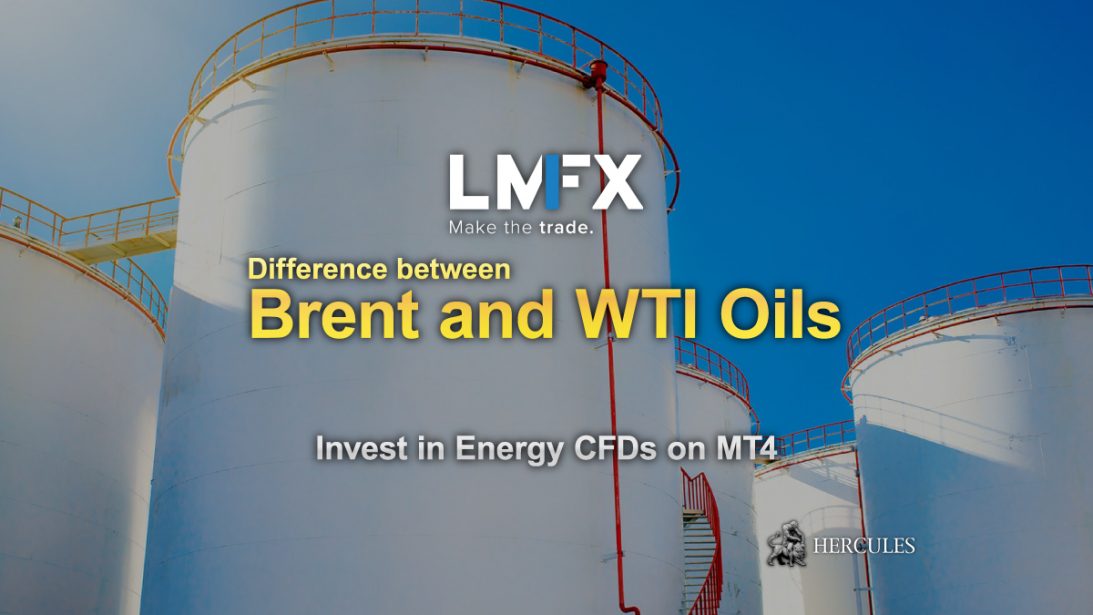Difference between Brent and WTI Oils - Invest in Oil Markets with LMFX


Brent and WTI – What is the difference?
When you read or hear news about the oil market, you will come across two mysterious words: Brent and WTI (West Texas Intermediate). Perhaps you already know these are the two main instruments for oil. But do you know what is the difference between them and why they have different prices?
We have collected important information about Brent and WTI so that you can profit from trading on these two instruments.
Let’s start with the basics. There are many variations and grades of oil in the world, but only 3 types of oil are the main benchmark. They are Brent, WTI, and Dubai Crude. We will talk about Brent and WTI because these two instruments are the most used because they are ideal for refining oil into fuel.
Why was this benchmark created?
This happened in the late 1980s when OPEC (the largest oil-exporting organization in the world) refused to regulate oil prices so that oil prices depended on trader sentiment. Exporters needed a point of orientation to determine the right oil price, so Brent and WTI were created. So now every oil producer can determine the price of the oil it produces according to the main benchmark level of oil.
If you think that Brent or WTI is just one of the oil grades, then you are wrong! They are just common names for different grades of oil and have different characteristics.
Let’s look in more detail at their characteristics
The first is that Brent’s location is the standard for European and Asian markets. The benchmark consists of more than 15 grades of oil produced on the Brent shelf block in Norway, Scotland, including Ekofisk, Oseberg, and Forties.
WTI is the benchmark in the western hemisphere. WTI is sourced from the main oil fields in the USA, namely in Texas, Louisiana, and North Dakota.
The second characteristic is the chemical formula. First, it needs to be said that no oil value is exactly the same. Even the values included in Brent or WTI have a different structure.
Brent is a lighter type of oil with a low sulfur level, while WTI is a denser oil. WTI quality is higher than Brent.

Start Trading Oils on LMFX MT4
Why are the prices of Brent and WTI different?
Since the mid-1980s WTI and Brent have been selling for almost the same price, there have been times when WTI has been more expensive than Brent. However, WTI on average has a price below Brent, where the price difference varies between $ 10 – $ 20 per barrel.
Prices depend on production and transportation costs.
Brent is produced close to the sea, so transportation costs are low, whereas WTI is produced on land. As a result, there are additional infrastructure costs in North America which make transportation costs to market more expensive.
As we said earlier that the quality of Brent is below WTI, but Brent is the benchmark for oil and has a higher price due to the high demand for exports.
Another important factor to consider is geopolitical issues. Tensions in the Middle East put a huge burden on Brent especially, as geopolitical tensions led to a decline in oil supplies. You have to remember that when the supply of oil decreases, the price of oil goes up. West Texas Intermediate is less affected because it is produced in the lowlands of the United States.
The price of WTI is formed from crude oil inventories, once the amount increases, the price of WTI will decrease. Conversely, if the amount of WTI inventory decreases, the price of WTI will increase. Here you have to pay attention to the inventory problem, where when there is a lot of inventory, the price will go down.
So as you can see, the major benchmarks for oil are affected by a variety of factors, but their trends are pretty much the same. If the price of Brent rises, then there is a high probability that the price of WTI will also rise.
In conclusion, we can say that Brent and WTI will remain the main benchmarks of oil. If you want to trade in the oil market, then you should choose one of these main instruments. You should also keep in mind the factors that affect the price of the oil instrument you choose, so you can predict future oil prices more accurately so that you will be able to earn more profit from trading oil.
Comparison of LMFX’s all trading account types
LMFX has 3 trading account types which are Fixed, Zero and Premium.
See the comparison of these 3 trading account types below and choose the right account type for your trading strategy.
| Account Type | Fixed | Zero | Premium |
|---|---|---|---|
| Minimum Spread | Fixed from 1.8 pips | From 0.0 pips | From 1.0 pip |
| Maximum Leverage | 1:400 | 1:250 | 1:1000 |
| Minimum Deposit Amount | $250 | $100 | $50 |
| Trading Commission | None | 4 USD per lot | None |
| Account Currency | USD & EUR | USD & EUR | USD & EUR |
| Available Markets | Forex, Gold, Silver, Oil, Indices, Share CFDs and Commodities | Forex, Gold, Silver, Oil, Indices, Share CFDs and Commodities | Forex, Gold, Silver, Oil, Indices, Share CFDs and Commodities |
| Max Trading Volume | 75 lots | 100 lots | 60 lots |
| Max Number of Open Trades | 150 | 200 | 100 |
| Web Trader | Available | Available | Available |
| Mobile App | Available | Available | Available |
| Margin Call % | 30% | 50% | 50% |
| Stop Out % | 15% | 20% | 20% |
| Account Registration | Open Fixed Account | Open Zero Account | Open Premium Account |









